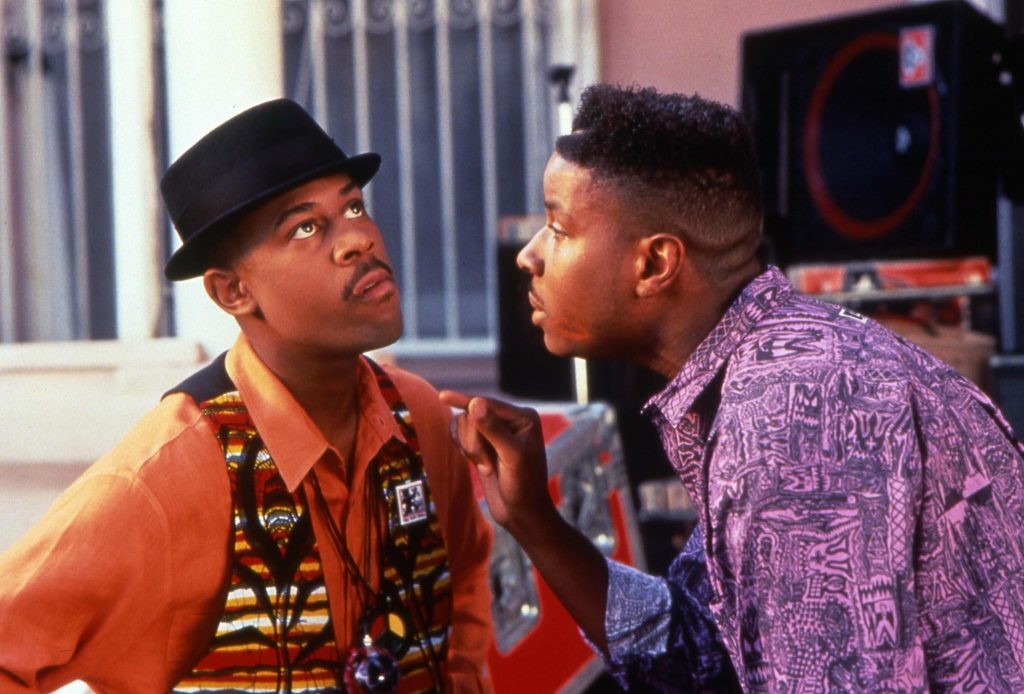House Party (1990)

I suppose that target demographics count for a great deal when it comes to the entertainment value that a film like House Party provides, so take this review for what it’s worth. At the time this was released back in 1990, I was a hip hop DJ for a college radio station, playing many of the songs on the soundtrack and occasionally we put on a dance or two not too dissimilar to the one shown in the film, with lots of hip hop, new jack swing, and colorful gear galore.
I had seen the film when it first debuted back in 1990, and enjoyed it quite a bit, but looking back today, it’s hard for me to divorce myself from a certain nostalgia for the look, sound and feel of the urban scene of 1990, when I was as deep into the music as I would ever be. Although this movie doesn’t really feature artists on the cutting edge of hip hop of the day, and Kid N Play would come to be known more for their appearance in the House Party movies than anything they ever did as recording artists, there is still a beauty in the way the dialogue is presented and in the fashion of the young African-American teenagers that keeps it interesting for those that embrace such things.
Obviously, at the center of the film is a house party, where the high school clique gets together for some fun, dancing, a little drinking, and a little romance. The gist of the story is that Kid (Reid), a hyperactive high schooler with an enormous high-top fade hair style, is grounded for misdeeds in school, but he still manages a way to sneak out and join the fun. Some of the emphasis is on the romantic connections that will form between two of the girls there, Sidney (Campbell, Little Shop of Horrors) and Charane (Johnson, Dying Young), which Kid (Martin) and his best friend, Play, seem to be vying for. Meanwhile, the high school bullies (Full Force) that got Kid in trouble to begin with are on the prowl for him, while everyone must overcome overzealous cops, whiny neighbors, and maintaining a rep among the peers.
Although it was a modest hit when it was released, the enduring legacy of House Party is that it would eventually set the trend for nearly every party film that would come after it (Can’t Hardly Wait is one prime example). It is also refreshing because it plays to its intended audience, but never speaks down to it, nor does it exclude people that aren’t part of the scene it portrays from enjoying it. Unlike many other films which featured African-American casts of the time, it doesn’t beat you over the head with forced positive messages, and conversely, it is mostly devoid of gangster drama, drugs, or serious crime that usually rear their ugly heads whenever an all-Black cast emerges ina Hollywood film. While there is some very subtle commentary on the nature of police suspicion of Blacks, safe sex, and drinking, they never veer into contrived melodrama, and in fact, they add a good deal of humor to the proceedings without seeming anything like a public service announcement.
Written and directed by Reginald Hudlin (The Ladies Man, Serving Sara), the main strength of the film comes in the masterful understanding of the vernacular of the times, with lingo that rolls off of every character’s tongue without any explanation of meaning necessary. Many people not in the know may not have heard some of the phrases before, but it’s easy to catch the gist of what is meant within the context of the film. Hudlin also does very well with the character development; all of the characters are very well-rounded, resisting conventional stereotypes to be original, realized people. Friends portrayed in the movie seem like they have a history with each other, while even minor characters, like the families of the kids, are developed in full detail as well. Hudlin has crafted a rich, knowing and fun little movie celebrating the lifestyle of middle-class Black teenagers of that era with beautiful precision.
House Party might be very dated in terms of the music and fashion, but, because of the aforementioned authenticity in which these are presented, this will give older viewers an extra level of enjoyment, recapturing certain memories of the era that they may have had, or if they were never part of that world, laughing along with it. It’s a shame that future entries in the series couldn’t recapture the spirit of this film, marred by some of the same stereotypes and need to force positive messages that this film wisely avoided. House Party is all about the fun and nothing more, realistically portraying its characters, its music and its shared experience in a way that will allow even those that have never been a part of the culture showcased so vividly to embrace it as their own.
— Followed by three inferior sequels: House Party 2, House Party 3, and the Kid N Play-less House Party 4: Down to the Last Minute
Qwipster’s rating: A-
MPAA Rated: R for language, mild violence and sexual humor
Running Time: 100 min.
Cast: Kid N Play (Christopher Reid and Christopher Martin), Robin Harris, Martin Lawrence, Tisha Campbell, A.J. Johnson, Paul Anthony, Bow-Legged Lou, B-Fine, Barry Diamond, Mike Pniewski, Gene “Groove” Allen, Daryl Mitchell, John Witherspoon, George Clinton, Reginald Hudlin (cameo), Warrington Hudlin (cameo)
Director: Reginald Hudlin
Screenplay: Reginald Hudlin
